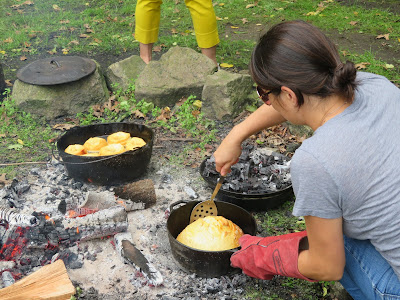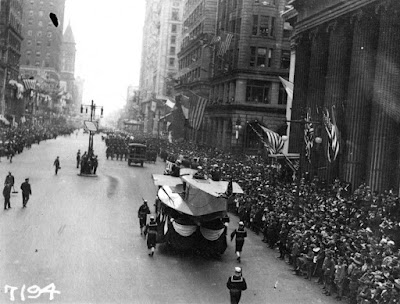Ask an Archivist 2018
On Wednesday, October 3, join four archivists from the Pennsylvania State Archives as they test their knowledge on Twitter. Kurt Bell, Rich Saylor, Aaron McWilliams and Tyler Stump will take part in Ask an Archivist Day. Sponsored by the Society of American Archivists, Ask An Archivist offers the public the opportunity to connect directly to archivists in their community. Archivists around the country will respond to questions tweeted with the hashtag #AskAnArchivist. Questions will vary widely, from the silly (What do archivists talk about over lunch?) to the practical (How do I preserve records that were damaged in a flood?) Ask an Archivist Day is open to everyone - all you need is a Twitter account. To participate, just tweet a question to @PHMC and include the hashtag #AskAnArchivist in your tweet. Our archivists will see your question instantly. Here’s our schedule:- 10-11 am: Richard Saylor will share his research into the unusual records he's discovered within the collections of the State Archives
- 11 am-noon: Kurt Bell will focus on Pennsylvania's railroad history, especially the records held by the Pennsylvania State Archives and the Railroad Museum of Pennsylvania
- 1:30-2:30 pm: Aaron McWilliams will answer your questions regarding genealogy and family histories. Ask Aaron about the celebrities, such as Katey Sagal and Steve Buscemi, who have visited the Archives
- 2:30-3:30 pm: Tyler Stump will share his knowledge regarding the Pennsylvania State Archives' institutional records, particularly those from mental institutions and prisons
Looking Back at September
 |
| Battle of Lake Erie commemoration with U.S. Brig Niagara (left) and schooner Lettie G. Howard (right) in background (photo Linda Bolla) |
 |
| The annual Battle of Lake Erie commemoration includes a wreath placed into the water, this year off the Museum plaza (photo Linda Bolla) |
 |
| Part of the cast iron cooking demonstration at Cornwall earlier this month (via Facebook) |
 |
| See more yummy food and other seasonal products at Landis Valley's Harvest Days event, Oct. 13-14 (via Facebook) |
And while we're on the subject of food (I consider wine one of the essential food groups), Old Economy Village just reopened the historic wine cellar on the property after a restoration project (more photos on Facebook). You can check it out for yourself at Erntedankfest: A Harvest Festival, Oct. 6-7.
 |
| Friends of Old Economy Village enjoy a members-only preview of the restored wine cellar beneath the Mechanics Building (via Facebook) |
This weekend...
Anthracite Heritage MuseumSept. 28: Fundraiser—Cooper's Seafood House in Scranton hosts a charity night on the last Friday of every month, and this month Anthracite Heritage Museum gets 100% of the proceeds. Details on the restaurant's website. 5-8 pm.
Bushy Run Battlefield
Sept. 29: Fall Nature Walk—Bushy Run volunteers and nature enthusiasts will lead a tour to help you learn about the local flora and fauna on the grounds. Cost is $5 (free for members). 10 am.
Daniel Boone Homestead
Sept. 29: Heritage Day—all kinds of activities will take place throughout the site. Cooking, baking, dancing, magic, and much more (details on the calendar of events.) Admission charged. 10 am-4 pm.
Drake Well Museum and Park
Sept. 29: Something More Saturday—family-friendly craft activities are included in regular admission today (check the Facebook event page for more info). Blacksmithing demos will also be offered. 10 am-3 pm.
Graeme Park
Sept. 28: Homeschool Day—activities include tours of the Keith House, open-hearth cooking, colonial games, and typical chores (program info). Cost is $6 per person; students must be accompanied by a responsible adult. 10 am-2 pm.
Pennsbury Manor
Sept. 29: PA Governor's Panel and Luncheon—PLEASE NOTE that Pennsbury will be closed to visitors 9/29 to allow for this event: current governor Tom Wolf and several former Pennsylvania governors will discuss the challenges of leading the commonwealth established by William Penn. A 3-course lunch will be served. A portion of the proceeds from this event will go toward establishing the "William Penn Scholarship Fund" for Title I schools. Tickets may be purchased online through TicketLeap. More information on the program, group tickets, and sponsorships is available on the Pennsbury website. 1-4 pm.
Sept. 30: Meet the Animals—visit with some of the animals that make Pennsbury their home. Included in regular admission. 1-4 pm.
Railroad Museum of Pennsylvania
Sept. 29: Members Day—a full slate of activities and speakers is planned for Friends of the Railroad Museum (and it's not too late to join). Full info on the website.
State Museum of Pennsylvania
Please check the Planetarium page for program schedule.
Sept. 28 & 30: Mammal Hall activities—today (9/28), there's Curiosity Kids: Walk Like the Animals! and Make Your Own Paper Diorama at 11:30 am. On Sunday (9/30), celebrate the rededication of Mammal Hall, marking its 50th anniversary, with activities starting at 12:30 pm. General admission is $5 per person today through Sunday.









